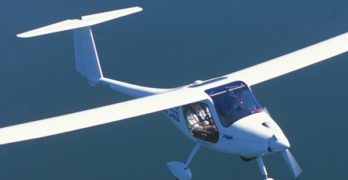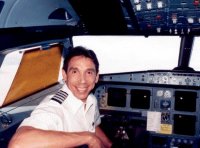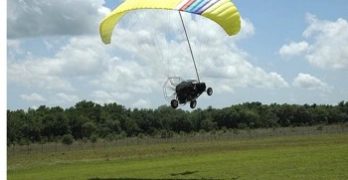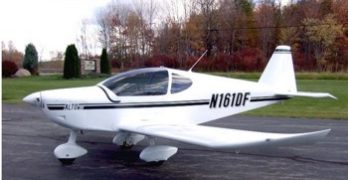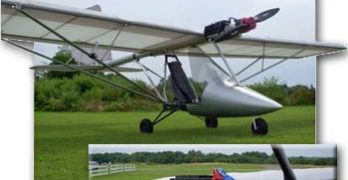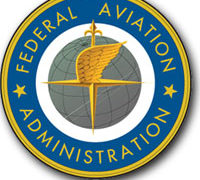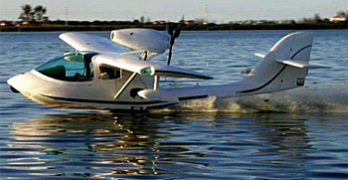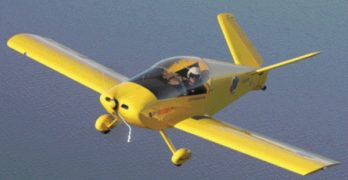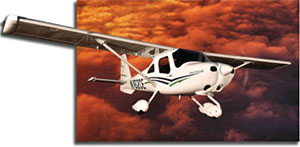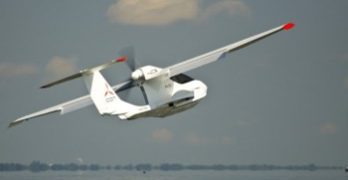Many Americans will agree
the name of this aircraft is odd, and that may be a kind word for the common reaction to “Sinus.” Is the name that important? Sinus (pronounced Seen-us), the aircraft, is a sleek, slender machine capable of impressive performance.
Any soaring-attuned pilot can easily live with the name Sinus for the 49-foot span and, get this, 28-to-1 glide performance! On first glance, except for its elegant, shapely, and thin wings, the Sinus looks like a proper light sport airplane. Pilot Matevz Lenarcic flew one around the world solo, in 80 days, and with zero ground or air support (see “Microlight Motorglider Flies Around the World,” April ’05 UltralightFlying! magazine).
What’s In a Name After All?
Let’s consider that name. U.S. dealer Robert Mudd says Pipistrel – the manufacturer – prefers to pronounce it “seen-us,” not “sighn-us.” They say this refers to a perfect sound wave or sine wave rather than a head cold.
Search Results for : Flight Design
Not finding exactly what you expected? Try our advanced search option.
Select a manufacturer to go straight to all our content about that manufacturer.
Select an aircraft model to go straight to all our content about that model.
Larry Newman, 2011
Larry Newman, 63, one of the seminal manufacturing/marketing dynamos in the early days of hang gliding who made the successful transition to ultralights, has died after a reported 3-year battle with pancreatic cancer. *** Larry was a flamboyant entrepreneur who successfully sold his ElectraFlyer hang gliders. *** When people started sticking motors on the foot launched craft, he came out with a new company, American Aerolites, to produce the Eagle ultralight. *** I first flew the Eagle with Plane & Pilot Publisher Steve Werner back in 1983. I remember it vividly: while Steve was up on a test hop, I was taking photos of his flight next to the runway at Coronado Airport, north of Albuquerque, near Larry’s factory…and I got stung twice by fire ants.I almost jumped out of my jeans, it hurt so bad. I thought I’d been shot in the leg. I could barely see the critters but what a painful wallop they packed.
Maverick Goes Mega-Viral!
The dark horse, literally, to claim the Flying Car throne is the all-black I-Tec LSA-certified Maverick Sport. *** We’ve talked about it here a lot, and now the “airable” dune buggy seems to really be catching on with the public. *** I-Tec turned the flying car concept design on its head by designing a lightweight off-road car first: the ability to fly it was always the 2nd priority in the design phase. *** The result is a lightweight, off-road-sturdy, flying car that will — and this is straight from I-Tec’s Steve Saint — accelerate from 0-60 mph in 3.9 seconds. *** Holy flying Jaguar XKE, Batman! *** To prove it’s road chops, Steve and the I-Tec crew drove it 1,500 miles to Oshkosh last summer with the paraglider-like wing tucked into its roof pouch. *** In a preview of the 18-hour days they would face while swamped by a fascinated public at Airventure, the crew never made a fuel stop en route that took less than an hour — everybody had to know everything about the Maverick.
Corbi Alto is #112 SLSA!
In my post after last spring’s EAA Sun ‘n Fun convention in Lakeland, FL, I told you a bit about the Corbi Alto 100, a new, purpose-built SLSA (see List) that entrepreneurs Ron Corbi, a longtime figure in aviation, and Dan Coffey said should be done by the end of the year.
True to their word, I got an excited email from Ron today that read, “It’s finally an SLSA!” Congratulations to all the crew at Corbi Air, an established aircraft sales outfit in Salem, OH that’s been a family business for more than 50 years.
The Czech Republic-designed Direct Fly Alto was reworked by Ron and Dan to enhance what they called the aircraft’s “maintainability,” by including features like American-made brakes, bucked rivets replacing pop rivets, an electronic electrical system and a Dynon Skyview…all for $99,995.
As you can see, the canopy slides forward for easy entry opening in flight.
Part 103 Enthusiasm Continues; Welcome E-Spyder!
Part 103 continues to step from the shadow of Light-Sport Aircraft. We’ve had aviation’s simplest rule (worldwide!) for 27 years and with few exceptions, most of those years saw Part 103 producers laboring in near-obscurity. *** Now, however, a new flurry of activity has developed at the beautiful intersection of genuinely lightweight aircraft with electric power. The very latest to roll into the spotlight is Flightstar‘s E-Spyder, which took its first flight today. E-power from Yuneec in China meets an all-American airframe. The accompanying photos show what a clean matchup these components achieve. *** Flightstar mounted the twin lithium polymer battery packs on either side of the design’s robust main fuselage tube. Electric motors are more user-friendly in nearly every way, but you have some new learning to do. For example, experts advise never allowing lithium polymer batters to drain completely. Fortunately, the Yuneec controlling hardware provides warning systems to help you manage this task.
FAA Assessment Report
The following is taken from FAA’s “Light-Sport Aircraft Manufacturers Assessment” Final Report issued May 17, 2010. It has not been edited or changed in any way other than to format for Web posting.
Light-Sport Aircraft Manufacturer Assessment
—– Final Report —–
Issued May 17, 2010
EXECUTIVE SUMMARY
This report presents the results of the Light-sport Aircraft Manufacturers Assessment (LSAMA), (herein referred to as assessment and team). This executive summary briefly discusses the assessment team’s analysis, conclusions, and recommendations based on data collected during the assessment.
GOAL
The assessment team’s goal was to review current LSA manufacturing industry systems and processes through on-site evaluation, analysis, and reporting. The team was also tasked to recommend enhancements to industry consensus standards for LSA design, manufacturing, continued airworthiness, and maintenance and FAA processes and procedures. The team’s methodology was to collect data from LSA manufacturers, including their extensions and distributors, located in the United States.
Landing a Seaplane on Water… with Wheels Down!
Landing on water with your wheels down is a confirmed aviation no-no. Land planes that try it often get flipped over upside down, when escaping the cabin becomes a real concern. Every seaplane pilot I know has a mantra he or she repeats, “I’m landing on water so the wheels must be up.” Most simply don’t want to make this mistake. You can land a seaplane or floatplane on land with the wheels up. The penalty is not as great (and you’ll certainly stop fast). But you violate the wheels-into-water rule at your peril. *** Some airplanes, like the new CTLS on amphib floats, or FPNA’s Capetown, or SeaRey have a light-alert system to help you and some manufacturers offer an audio alarm. Others use mirrors or have other warning systems. *** So why would someone land a SeaMax in water with the wheels down?
Sonex Aircraft’s Y-tailed Waiex
Pedal to the Metal
The Y-Tail Waiex combines unusual style with refreshing speed.
The airlines may be suffering and
Light-Sport Aircraft (LSA) has yet to
coalesce into a coherent industry
segment, but Sonex Ltd. is having a fine run
of business. During my visit on a beautiful
fall day in Oshkosh, Sonex said it was ready
to break ground on a new hangar, the third
building of what has become the Sonex
campus on Wittman Field. At press time, it
was nearly complete.
Sonex is clearly ready for LSA, but
the company has built its enterprise on
delivering kits to the Experimental/ Amateur-
Built community. Steadily selling kits
keeps Sonex in good business shape while
LSA comes into focus. This company is well
positioned for whatever future recreational
flying holds.
$22,260. That calculates to an amazing $148
per mph.
Most of us don’t think in terms of
dollars per mph-and the comparison
with the RV-9 ignores the fact that
the RV is larger, heavier and, as a result,
more cross-country capable-but it
certainly proves that the Monnett machine
won’t take too much of your money for the
speed it can deliver.
A Raging Debate… IFR, IMC, VMC, and LSA
In the last month, I’ve received many calls and emails from more than a dozen flight schools. Here, I will try to reduce the confusion — and some alarm — regarding IFR (flying by instrument reference) and LSA.
ASTM’s F37 committee is comprised of people with technical knowledge and they have done the nearly-impossible: start with a blank sheet of paper and create aircraft certification standards for the LSA sector… in just five years, and on the leanest of budgets. These volunteers from many countries created a series of standards, one of which is the Design and Performance Standard. Following a positive vote by committee members, all have been accepted by FAA.
For more than three years another subcommittee has tried to create an IFR standard that has yet to find agreement. Until consensus may be found and to provide an interim defensive position for the committee and for manufacturers, F37 added a point to the revised but yet-to-be-accepted-by-FAA D&P Standard.
Icon A5 Update
In mid-water taxi toward its anticipated production date sometime next year, Icon Aircraft was at Oshkosh again with an impressive display booth/tent/hangar, and every time I walked by, whether early morning or late at night, there were always people ogling that beautiful airplane. *** The company has made two major design changes over the last few months which are interesting and worthy of attention. (1) The wing flaps are gone, ostensibly to “simplify” pilot operations. Company spokesfolk say they weren’t getting sufficient benefit from the flaps to justify their weight and complexity. (2) A desire to work in more spin resistance has led to airframe tweaks, including wing cuffs to lower the stall speed of the composite carbon fiber SLSA. *** I and others had wondered, after our first looks at that streamlined profile when the A5 debuted a couple years back, how Icon was ever going to get stall speed below the 45-knot minimum, even with flaps.
- « Previous Page
- 1
- …
- 101
- 102
- 103
- 104
- 105
- …
- 147
- Next Page »


